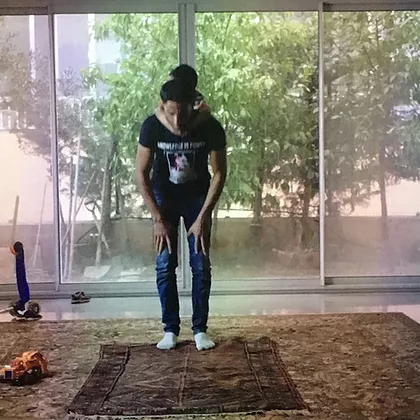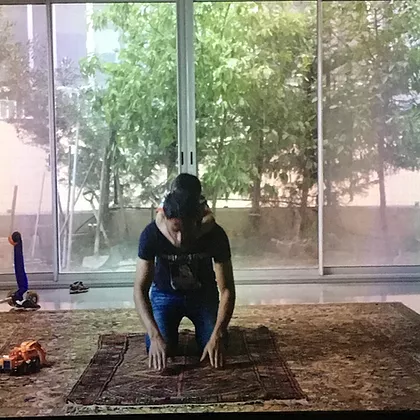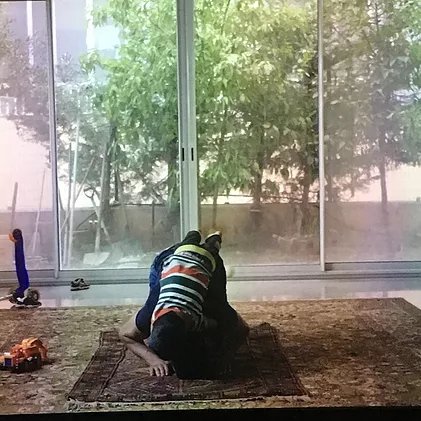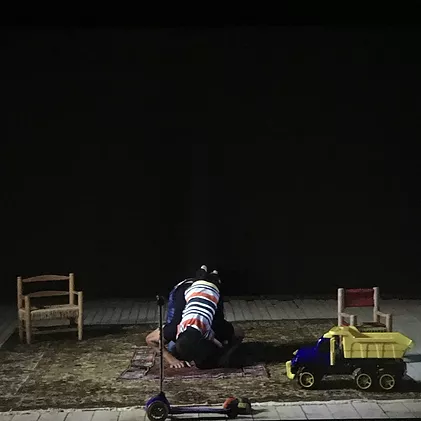Akram Zaatari @ New Art Exchange
ZM + GDLP
Emoji summary: 👨👦🤹♂️❤️
At New Art Exchange in Nottingham: there was a single film upstairs on loop, floor to ceiling projection, u sat on a bench in the dark 2 watch ‘The Script.’ A young Father in a modérn apartment stood facing the camera, bare feet on a large persian rug. Silently he raised his hands to his head in Takbir, dropped his body into a bow. His tiny son zoomed into frame on a plastic truck n jumped off and climbed up his father’s leg, onto his back. As the Dad fell to his knees, head on the ground in Sujud, his son rolled over his Dad’s back onto the floor in front of him, laughing. The kid jumped around, climbing up his Dad’s back, falling off when his Dad dropped into Sujud, running around;; again n again; and eventually a second son joined the family scene, this 1 younger and louder. They played together on the persian rug, and rested on their Dad’s shoulders until he was bent in prayer. This dance unfolds, all as his Dad cycles through the Rakats.
the scene shifts just once: from the exact same choreography n same components of father, two sons, persian rug, and plastic truck, but this time on an empty stage. This weird dance in tender silence and prayer, edged by toys and kid-debris. Felt like a caress. I remember when I was little, my Dadi used to pick me up from nursery and we’d walk home. I’d sit and eat my lunch while she prayed Zuhr, and with carrot sticks clutched in my fat hands, sometimes I’d run and bow down next to her in Sujud and whisper into the carpet. This film felt like the kind of unspoken acknowledgement I knew deeply as a kid; but also a choreography that felt pointed when repeated on stage in that exact set up. Like rehearsal, like practice, like millions of muslims 5 whole times a day; like evening after a matinee; this film didn’t speak this unspoken acknowledgement aloud in a way, it just let you see it from another angle. repetition after a control. I liked that sleight of hand ! that slow n soft reveal of letting you come to your own conclusions. You inevitably draw on your own experience and memory; ((read: cultural experience, cultural memory)) when the art leaves you to it. I appreciate and want to lean into that specificity, that generosity of elasticated waistbands.
The man on the bench next to us watched it too n he was smiling. told us he was from Egypt, where he still ran his business. He felt like someone who had accidentally walked into the gallery space but found it was kind n decided to stay. I just wanted to mention that, bc it seemed to be natural for New Art Exchange tbh, that the visitors who come thru the doors to socialise in the cafe become an audience that might happen upon the art as well. Incidental experience ~ more real n good. A guess, a guess.
The Script was a new commission between NAE, Thomas Dane + the Arts Council, but downstairs was a 4 floor to ceiling screen installation of found footage around a large concrete column, ‘Dance to the End of Love.’ One of them would start, slow and quiet, ripped youtube clips of a guy lifting weights; then hard and loud, all 4 screens burst into noise, a kid singing an arab pop song (i couldn’t recognise bc i literally only know Nancy Ajram sksksk). And then DIY CGI of boys throwing thunderbolts and fireballs, and pickup trucks driving on their two side wheels on a motorway in the desert. A kind of online feral-ness that has the same cultural specificity in where and how it circulates. There’s this one video of kids doing garba on hoverboards that my family sent around last year and the year before was a video of ‘’’’’’’selfie garba’’’’’’’’ (((hard quote))) n i cannot wait for this year’s viral garba sensation to hit the family groupchat. This,,, i am interested in this and i don’t know what to do with this interest or where to put this interest beyond gesticulating at the archive or the internet as an archive or whatsapp media as an archive. I feel like it is distinctly Western to categorise things in this way; to handle things n objects as ‘ArTeFaCtS’. And as I say that I also don’t wana commit to it (mostly bc i don’t want any archive nuts to @ me) but also bc idk if i agree. I feel like any kind of empirical or quantifiably intellectual tidy archiving will always be a western invention n maybe the archive of the global south’’’ or whatever we’re calling wherever poc come from originally now. ‘’’ this archive is intuitive and looser, a process of categorising like the Lazy Susan or the amount of tupperware in my mum’s kitchen cupboards. This archive of the 4 screen installation, this felt specific, Curated… it felt like it had a purpose or an end goal n idk what that was, but i think it might have been understanding;; Entertainment;; body raised up and acting alone, performing in so many instances. Sometimes art is like, a thing you have made that you have to hold at arms length, check yourself, and post rationalise so you can make heads or tails of it. Dance to the End of Love was made in the opposite way i think, i think Zaatari knew what he was doin and i liked that. It was like orchestrated research. Pernickety and musical. I had to go in and out of the room three times to figure it out.
There was a final tiny gallery room of photograph portraits from Lebanon mid 50s to 70s but I swear I just cannot get myself to stick around for photography, and i dont think the curation was anywhere near as engaging as had been set for the works we’ve described above. All I can say is I have nothing to say about this, no feels, blank face. But this exhibition is touring so i’ll be interested 2 see how others hold these images. I will have to follow it to around the country.



